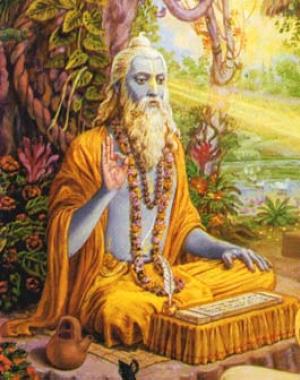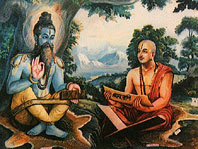
Some Brief Information About Srila Vyasadeva.

In Srila Vyasa's childhood he was called Krsna, because of his dark
complexion, and because he was born on an island at the confluence of the
Sati and Mati Rivers he was called Dwaipayana. After dividing the Vedas
he got the name Veda Vyasa. There are some who say that Krsnadwaipayana
Veda Vyasa took his birth at a place now known as Vyasa Goofer, the cave
of Srila Vyasa in present day Nepal, on the road from Pokara to Kathmandu
which was, in days of yore, part of the kingdom of King Janaka. There are
local records that support this statement, which say this was the 'ashrama'
of Parasara Muni and at this place Srila Vyasa was conceived. They also
lay claim that later Srila Vyasa came back to that 'ashrama' and stayed
there for some time, and this being why there is a small Deity of Him at
the entrance of the cave. The Padma Purana however says that he was conceived
on an island created by Parasara in the Yamuna river, (Padmalocana Prabhu's
book entitled "Yamuna Devi, The Personification Of Prema Bhakti", Page
24.), in connection with the place known as Soma Tirtha ghat. Some also
say that the birth place was at Damauli.
Anyway, everyone at least agrees that the date of Srila Vyasa's
appearance was on the twelfth day of the light fortnight in the month of
Vaisaka (April-May), called Vasant Dwadasi.
The following is the story that we just touched upon mentioning how
Srila Vyasa came to make His appearance.
Once the hermit Parasara became attracted to a fisher girl of
the name Matsya-Gandha who was found inside a fish. (The fish was actually
a celestial maiden named Adrika who conceived two children by collecting
the semen of the King of Chedi when his semen had fallen into the water
of a river after seeing two animals engaged in coitus.) Parasara
Muni asked the beautiful Matsya-Gandha, so named because of her fishy aroma,
to take him in her boat from one side of the river to the other, but the
beauty of this damsel, her bodily movements from the rowing, aroused lusty
desires in Parasara. When he sat close to her she moved away, and asked
him not to violate her chastity, but Parasara Muni being already too far
carried away, created an artificial fog on the river and seduced her right
there in the boat. He then created an island in the river and on that island
the girl conceived a child in her womb. Parasara explained to her that
even after the child was born she would remain a virgin and the son born
to her would be a portion of Lord Visnu and would be famous throughout
the three worlds. He would be a man of purity, the spiritual master of
the entire world, and He would divide the Vedas.
Srila Vyasa soon grew into everything that Parasara had described,
and had many disciples.
Later in life it is recorded that Srila Vyasa returned to this island in the river and there compiled the Srimad Bhagavatam. Recorded is another instance when Srila Vyasa called for Ganesha (the elephant-headed 'deva') to write the Mahabharata as he related it to him. He did so on the condition that Srila Vyasa continually recited, and Ganesha, having perfectly understood the meaning, wrote down the Mahabharata. The word "Vyasa" means one who describes elaborately.
"The great sage, Srila Vyasa who was fully equipped with knowledge, could see through his transcendental vision the deterioration of everything material, due to the influence of the age. He could also see that the faithless people in general would be reduced in duration of life and would be impatient due to lack of goodness. Then he contemplated for the welfare of men in all statuses and orders of life. He saw that the sacrifices mentioned in the Vedas were means by which people's occupations could be purified, and to simplify the process, he divided the one Veda into four, in order to expand them among men. The four divisions of the original sources of knowledge (the Vedas) were made separately, but historical facts and authentic stories mentioned in the Puranas are called the fifth Veda."(Srimad Bhagavatam 1:4:17-20.).
"Thus the great sage Srila Vyasadeva, who is very kind to the ignorant
mass, edited the Vedas so they might be assimilated by less intellectual
men. Still he was not satisfied, even though he was engaged in working
for the total welfare of all people. Thus Srila Vyasa, being dissatisfied
in heart, began to reflect within himself. 'I have, under strict disciplinary
vows, unpretentiously worshipped the Vedas, the spiritual master and the
altar of sacrifice. I also abided by the rulings and have shown the import
of disciplic succession through the explanation of the Mahabharata, by
which even women, shudras and others (friends of the twice born) can see
the path of religion. I am feeling incomplete, though myself I am fully
equipped with everything required by the Vedas. This may be because I did
not specifically point out the devotional service of the Lord, which is
dear both to perfect beings and to the infallible Lord'."
"Srila Narada Muni (who was another son of Prajapati Brahma)
reached the cottage of Srila Krsna-dwaipayana Vyasa on the banks of the
Sarasvati, where Srila Vyasa was staying at that time, just when Srila
Vyasa was regretting his defects. At the auspicious arrival of Srila Narada,
Srila Vyasadeva got up respectfully and worshipped him, giving him veneration
equal to that given to Sri Brahmaji, the creator. Srila Narada then said:
'O Srila Vyasadeva, your vision is completely perfect. Your good fame is
spotless. You are firm in vow and situated in truthfulness, and thus you
can think of the pastimes of the Lord in trance for the liberation of the
people in general from all material bondage. The people in general are
naturally inclined to enjoy, and you have encouraged them in that way in
the name of religion. This is verily condemned and is quite unreasonable.
Because they are guided under your instructions, they will accept such
activities in the name of religion and will hardly care for prohibitions.'
And so Narada Muni, Srila Vyasadeva's spiritual master, instructed Srila
Vyasa to compile the Maha-Bhagavat Purana (Srimad Bhagavatam) now in his
maturity for the benefit of all mankind, to which Srila Vyasadeva agreed.
He presented the glories of Krsna and His many incarnations just after
the departure of Lord Krsna from this world. (Excerpts from Srimad Bhagavatam
1:4:24-33.).
"In this yuga the son of Parasara, who is glorified as a part of Visnu
and who is known as Dvaipayana, the vanquisher of all enemies, became Srila
Vyasa. Urged by Brahma, he undertook the task of classifying the Vedas.
Srila Vyasa accepted four disciples to preserve and continue the Vedas.
They were Jaimini who took care of the Sama Veda, Sumantu - the Atharva
Veda, Vaisampayana - the Yajur Veda and Paila - the Rg Veda, and for the
Itihasa and Puranas - Lomaharsana."(Sri Vayu Purana 60:10-16.).
According to Vayu Purana it says, "Previously there have been
twenty-eight Vyasas, but when the twenty-eighth appears, Lord Visnu, the
most Glorious, Great Father of the three worlds, becomes Dvaipayana Vyasa.
Then Lord Sri Krsna, the best amongst the Yadus will be born of Vasudeva
and will be known as Vasudeva. Then in due course I (Vayu) will come in
the form of an ascetic and assuming the body of a religious student, will
surprise the world by means of the Lord's 'yoga maya'." (Vayu Purana 23:206-208.)
Actually, this is Vayudeva announcing his appearance as Sripad Madhwacarya.

Madhwa presenting his Bhagavatatparayanirnaya to Srila
Vyasa
In the middle of my book there is a wonderful detailed description of the meeting of Madhwa and Vyaas at Vyaas's Uttara Bhadri hermitage, surrounded by thousands of tilaks (sages from all the Vaishnava sampradayas)......... there's a description from the tip of Srila Vyaasadeva's toes which resemble tortoises their long necks protruding from their bodies, to the top of his red matted hair, his tilak, his teeth that resemble jasmine buds, his eyes, etc., etc.